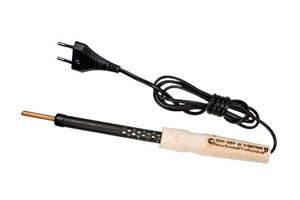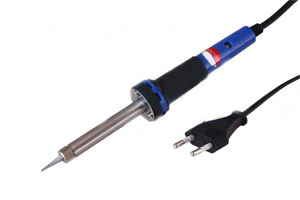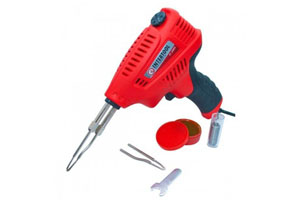 In this article we want to talk about such a tool as an electric soldering iron . This tool is the only one with which a competent person can repair a failed household appliance at home.
In this article we want to talk about such a tool as an electric soldering iron . This tool is the only one with which a competent person can repair a failed household appliance at home.
It is an electric element with a heating element, designed to apply solder to wires and contacts, when creating various electrical circuits and connecting wires. Structurally, an electric soldering iron consists of a wire with which it is powered from a conventional electrical network with a voltage of 220 W, a handle (body), a heating element and a tip.
Depending on the power and shape of the soldering iron tip, they are intended for various soldering jobs. So small soldering irons, power from 5 to 40 W are used for soldering various electronic boards, connecting small electrical circuits. They use small sharp stings, as they are more convenient to apply solder to the soldering point. Various tin-lead solders are used as solder.
Electric soldering irons from 60 to 100 W are used in the repair of electrical appliances and the home electrical network. Well, powerful electric soldering irons (more than 100 W) are mainly used only by professional electricians for soldering and tinning massive wires and parts. For mounting electronic devices, small soldering irons are often used, designed for a voltage of 12 - 36 watts. The power supply of the specified group of electric soldering irons is carried out from step-down transformers. Thus, the probability of damage to the components of electrical boards, primarily semiconductor ones, is reduced.
Types of soldering irons
1. Soldering iron with nichrome heater. A feature of this soldering iron is that the heating element in it is a nichrome wire spiral. If an alternating current from a household network passes through this spiral, or a low-voltage direct current, it heats up to high temperatures at which the solder melts. Good expensive models have a built-in temperature sensor with which you can control the heating temperature of the tip. It turns off when the desired temperature is reached, eliminating overheating and tool failure. A thermocouple is used as a temperature sensor for this type of electric soldering iron.
Structurally, nichrome soldering irons can be very different. The simplest heating system for a nichrome soldering iron is a nichrome spiral wound on a non-conductive body, inside of which there is a core that is used to spread the solder. In complex designs of this type of electric soldering iron, nichrome is embedded in special insulators. This reduces heat loss and increases heat transfer. Sometimes this type of soldering iron can be confused with a ceramic soldering iron, due to the fact that the heater is placed inside a rod of insulating material similar in appearance to ceramics.

2. Soldering iron with ceramic heater. In this type of electric soldering iron, ceramic rods are used as a heating element. They are heated by applying voltage to the contacts of the rod. Electric soldering irons of this type are considered the best. This is due to the fact that they are characterized by such qualities as fast heating, long service life, as well as a significant range of power and temperature control of the tip.

3. Induction soldering iron. In this tool, the tip is heated by an inductor through which an electric current passes. The tip inserted into the coil is coated with a ferromagnetic coating. If a current is passed through the conductor of the coil, a magnetic field with induced currents is created in it, which causes an increase in the temperature of the core. After the core reaches a certain temperature (Curie point value), the coating loses its magnetic properties and heating stops. Upon cooling, the process resumes. Thus, this type of soldering iron does not require an additional temperature sensor to maintain the desired temperature of the tip.

4. Pulse soldering iron. This type of electric soldering iron is characterized by very fast (within a few seconds) heating of the tip to the melting point of the solder. During the operating time, the power supply button must be pressed. If the button is released, the soldering iron starts to cool down. As a rule, they use a circuit in which the tip is part of an electrical circuit, which additionally includes a frequency converter and a high-frequency transformer.
The tip of this type of soldering iron is made in the form of a copper rod. The frequency converter increases the frequency of the current from the outlet to a voltage of 18 - 40 kHz, and the transformer reduces the voltage to 220 watts. The heating element itself - the copper tip of the soldering iron is connected to the current collector of the secondary winding of the transformer. As a result of this, a large current passes through the sting and the metal rapidly heats up.

|
Useful articles |